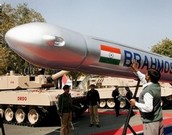India successfully test fires land version of BrahMos missile on Tuesday
 New Delhi, Jan 20 : In a move to assure its accuracy for future battles, the Army, on Tuesday, tested the land-attack version of BrahMos supersonic cruise missile near Pokhran in Rajasthan.
New Delhi, Jan 20 : In a move to assure its accuracy for future battles, the Army, on Tuesday, tested the land-attack version of BrahMos supersonic cruise missile near Pokhran in Rajasthan.
The test was declared as successful, having met all the parameters.
Earlier, on December 18, an air-breathing missile, with a strike range of 290-km, was tested for the first time from a vertical launcher fitted on a moving warship in the Bay of Bengal.
The government inducted the first battery of the BrahMos land-attack cruise missile (LACM) in July 2007.
Last month's launch of the missile took place from a vertical launcher fitted on Rajput-class destroyer INS Ranvir. The "universal vertical launcher'''' is fitted under the warship's desk protecting it from environmental conditions, provides flexibility to the missile system allowing it to be fired in all the directions and is harder to be detected by radars.
The Army further plans lies in progressively inducting three more BrahMos batteries constituting four road-mobile autonomous launchers on 12x12 Tatra vehicles, which will be used as a "precision strike weapon".
Three more stealth aircrafts, built at Yantar shipyard in Kaliningrad (Russia), at a cost of Rs 5,514 crore, are being armed with BrahMos missiles to make the weapon base stronger.
India and Russia have also started working on the "hypersonic" BrahMos-2, which can fly at speed ranging from five to seven mach. However, the work on BrahMos-1 is expected to take time.
The air-launch version of the missile will be united with a naval TU-142 aircraft for tests. The submarine launch version, however, is awaiting a suitable base for testing.
Future army plans consist of having nuclear-tipped LACMs with strike ranges of more than 1,500 kilometers. The specialty of this missile is powered and guided throughout their flight path.
Since they fly on low altitudes, they also have the ability to evade enemy radars and air-defense systems and are easier and cheaper to operate. (ANI)